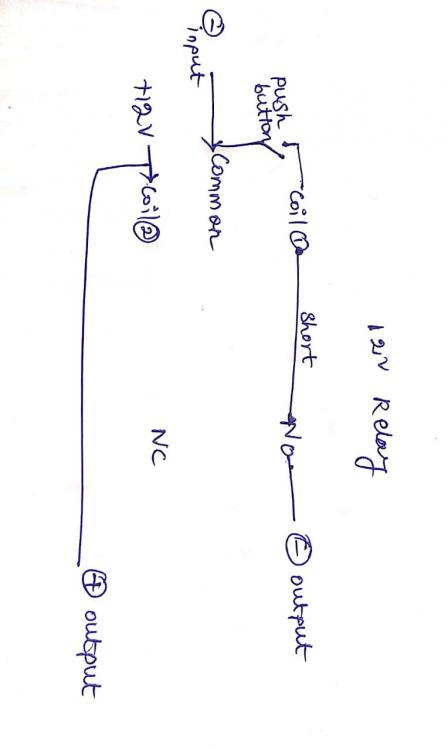Hi i am get the following short circuit protection circuit from the website it is working fine .The problem is when the 12v supply is on it is started from NC operation after pressing the push button only the output will come and if it is short circuit at the output the relay get turn off and it is change to NC.I want to modified this circuit as first it work with NO and if it is short circuit it is work to NC that is i want to avoid pressing push button at the start up and automatically it has to work to NO at first and if it is short circuit at the output it has to work with NC.i am unable to find the way to implement this logic.Please guide me to achieve this solution

marry roser
Overload relays are used in a motor circuit to protect motors from damage caused by prolonged periods of overcurrent. A short circuit occurs when current travels along an unintended path, often where essentially no electrical impedance is encountered.
The problem is when the 12v supply is on it is started from NC operation after pressing the push button only the output will come and if it is short circuit at the output the relay get turn off and it is change to NC.I want to modified this circuit as first it work with NO and if it is short circuit it is work to NC that is i want to avoid pressing push button at the start up and automatically it has to work to NO at first and if it is short circuit at the output it has to work
jaksonlee
Overload relays are used in a motor circuit to protect motors from damage caused by prolonged periods of overcurrent. A short circuit occurs when current travels along an unintended path, often where essentially no (or a very low) electrical impedance is encountered.

If you look at the circuit you will see that a short circuit across the output terminals will turn on the relay and thus disconnect the load from power supply. Thus if power supple is 12 V than the relay should turn on at least 12 V or above. If power supple if 5 V than you should use a 3 V relay instead because 3 V is less than 5 V. Keep in mind that all relays also have a maximum input voltage that should not be exceeded. If you look at the circuit you iwll see that the maximum relay input voltage should be above the value of power supply voltage to prevent failure of the relay.
The value of high power resistor is equal to: R1 = Power supply voltage/(Preferred maximum output current) - (Internal resistor of power source). The internal resistance is Rs. This value can be ignored if you do not know this value. With 12 V power supply the maximum current is 12 V / (Rs + R1) = 12 V / 20 ohms = 0.6 Amps.
In the circuit shown the LED is modelled with three general purpose diodes because the software used does not have an LED model. The old PSpice student edition software was used because it allows keyboard control and thus reduces schematic drawing time. New software simulation packages only allow computer mouse control thus increasing schematic drawing time. With the voltage across a typical LED equal to 2 V is approximately three times the voltage across a single diode, which is 0.7 V. The current across the LED should be 10 mA. Thus LED resistor is equal to: (12 V - 2 V) / 10 mA = 1 kohm resistance.


Sourav Gupta
Joined February 12, 2018 696Monday at 02:11 PM
The solution can be easily done without using a relay...
But it can be done by using a comperator circuit.
You can use this circuit.
https://circuitdigest.com/electronic-circuits/overcurrent-protection-ci…
If you really need a relay just change the mosfet with a appropriate relay. Do not forget to add a freewheel diode.